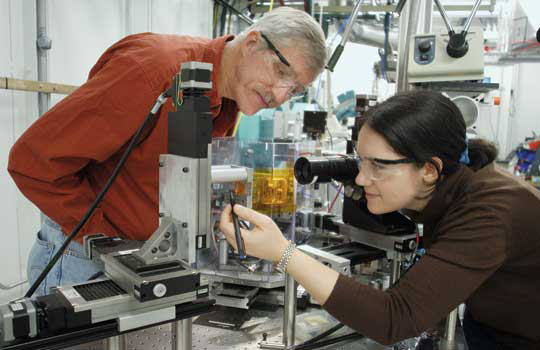A novel technique to study intracerebral iron oxide particles associated with Alzheimer's, Huntington's, and Parkinson's diseases has been developed. Researchers crafted a system of mirrors and lenses to tap one of the high-brightness x-ray sources at the Advanced Photon Source for the purpose of analyzing brain tissue.
Mark Davidson (left in the photo), University of Florida, and Joanna Collingwood, Keele University in the United Kingdom (UK, who is supported by a UK Alzheimer's Society Research Fellowship and Dunhill Medical Trust), align a sample of Alzheimer's brain tissue at the microfocus facility, MR-CAT, beamline 10-ID.
According to Davidson: “Unusual iron mineral nanoscale deposits have been associated with many neurodegenerative diseases, such as Alzheimer's, Parkinson's, and Huntington's. There is indication that these deposits (containing mixed oxide phases, such as magnetite) are involved in the oxidative stress of the tissue. The only way to find and identify these minerals was by extraction from bulk tissue samples, which does not provide information on the location of the particles in tissue. These particles are so small and widely dispersed, finding just one via electron microscopy could take months or years.
“We have built a microfocus x-ray absorption spectroscopy (XAS)/x-ray fluorescence (XRF) facility at 10-ID to address this issue. Using XRF from the high intensity of the APS x-rays, we can detect a single <50-nm iron oxide particle in a 200-µm square area, allowing rapid location of biomineral particles. After locating the particle to within <5 µm, we use XAS to identify the specific iron compounds present. The sample is analyzed with transmission electron microscopy to identify the associated biological structures. To our knowledge, this technique is the only one to have located and identified these compounds within tissue. The information obtained has great significance in understanding biochemical pathogenesis mechanisms, and in the development of new iron-chelation drugs for the treatment of neurodegenerative disorders. We are now working with other beamlines (18-ID at the APS) and synchrotrons (DIAMOND) to share these techniques and expand these new powerful capabilities.”
See also:
Contact: [email protected], [email protected]

